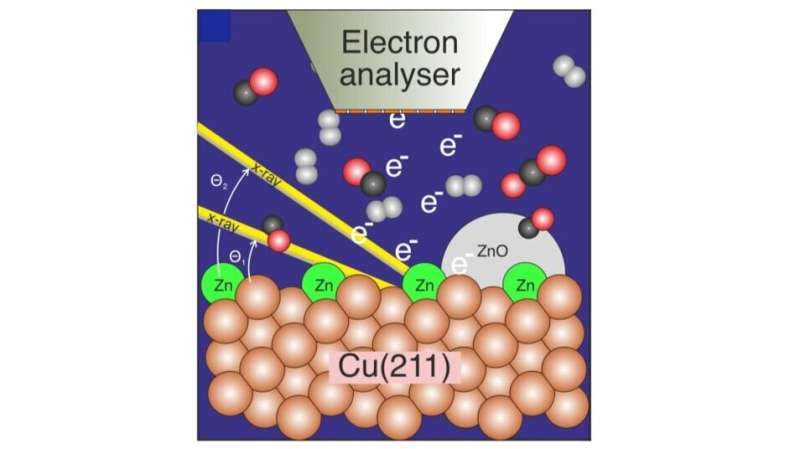Researchers unravel the active phase in catalytic carbon dioxide reduction to methanol

Researchers at Stockholm University have for the first time been able to study the surface of a copper-zinc catalyst when carbon dioxide is reduced to methanol. The results are published in the scientific journal Science. A better knowledge of the catalytic process and the possibility of finding even more efficient materials opens the door for a green transition in the chemical industry.
Methanol is currently one of the most important petrochemical basic chemicals, with an annual production of 110 million metric tons, and can be converted into tens of thousands of different products and used for the manufacture of, for example, plastics, detergents, pharmaceuticals and fuels. Methanol also has the potential to become a future energy carrier where, for example, aviation fuel can be produced using captured carbon dioxide and hydrogen from electrolysis of water instead of using natural gas. A future green transformation of the chemical industry, similar to the one with green steel, where wind or solar energy drives electrolytic cells is therefore a possibility.
"The challenge has been to experimentally investigate the catalyst surface with surface-sensitive methods under real reaction conditions at relatively high pressures and temperatures. Those conditions have for many years not been achievable and different hypotheses about zinc being available as oxide, metallic or in alloy with copper arose but could not be unambiguously verified," says Anders Nilsson, professor of chemical physics at Stockholm University.
"It is fantastic that we have been able to shed light into this complex topic of methanol formation over copper-zinc catalyst after many years of effort," says Peter Amann, first author of the publication.
"What is special is that we have built a photoelectron spectroscopy instrument in Stockholm that allows studies of catalyst surfaces under high pressures and thereby directly been able to observe what happens when the reaction takes place," says David Degerman, Ph.D. student in chemical physics at Stockholm University. "We have opened a new door into catalysis with our new instrument."
"We have succeeded using our instrument to demonstrate that zinc is alloyed with copper right at the surface and this provides special atomic sites where methanol is created from carbon dioxide," says Chris Goodwin, researcher in Chemical Physics at Stockholm University. "During industrial processes, a small amount of carbon monoxide is mixed in, which prevents the formation of zinc oxide from carbon dioxide."
"To have our Stockholm instrument at one of the brightest X-ray sources in the world at PETRA III in Hamburg has been crucial to conduct the study," says Patrick Lömker, Postdoc at Stockholm University. "We can now imagine the future with even brighter sources when the machine upgrades to PETRA IV."
"We now have the tools to conduct research leading to possible other catalyst materials that can be used better to fit together with electrolysis-produced hydrogen for the green transition of the chemical industry, which today is completely fossil-based and accounts for 8% of the world-wide carbon dioxide emissions," says Anders Nilsson.
More information: Peter Amann et al, The state of zinc in methanol synthesis over a Zn/ZnO/Cu(211) model catalyst, Science (2022). DOI: 10.1126/science.abj7747. www.science.org/doi/10.1126/science.abj7747
Journal information: Science
Provided by Stockholm University




















